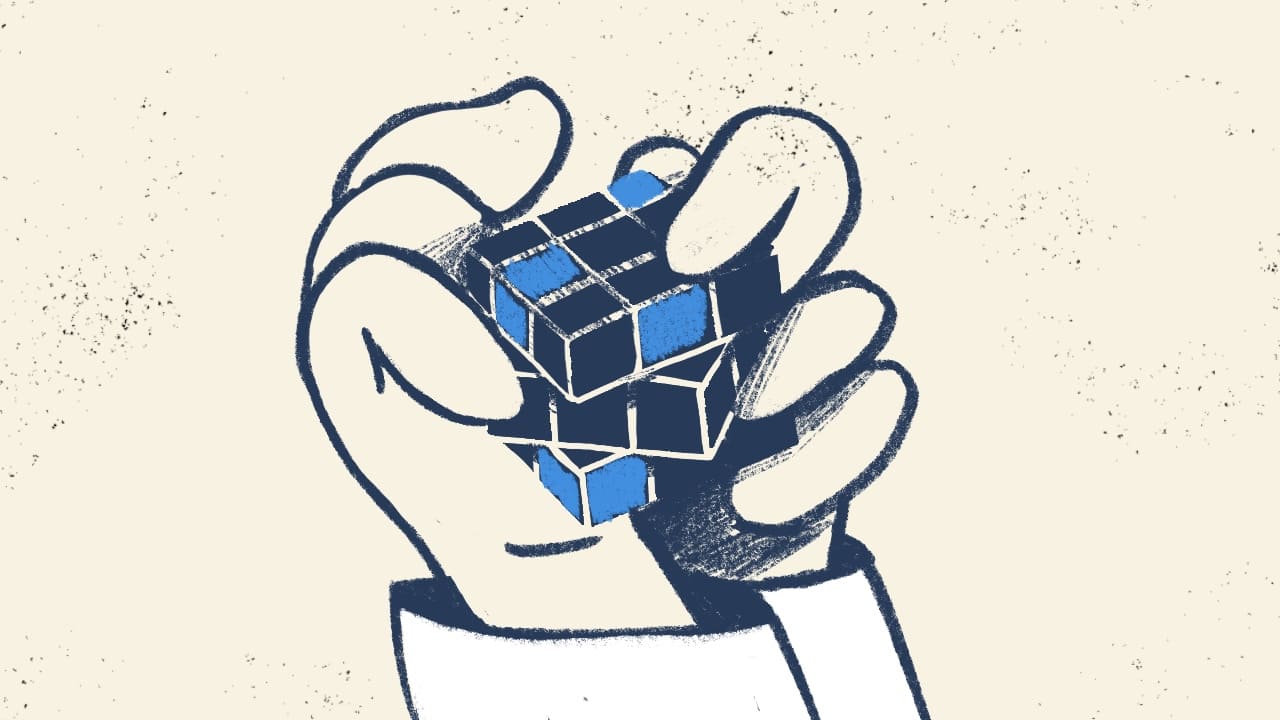Blended learning is revolutionizing the way we approach education, combining the best of traditional classroom experiences with the flexibility of online learning. Imagine a learning environment where students can engage with material at their own pace, participate in interactive online modules, and still enjoy face-to-face interaction with instructors and peers. Sounds exciting, right?
In this article, we’ll explore the ins and outs of blended learning, including its models, benefits, and how to create an effective strategy. Whether you’re an educator, corporate trainer, or simply curious about modern learning approaches, this guide is for you!
So, let’s dive in!
Unlocking Career Progression
Discover the strategies to lifelong learning and evolvement in IT
Download for free
What is blended learning?
Blended learning is an educational approach that combines traditional face-to-face instruction with online learning components. This hybrid model allows educators to leverage the strengths of both methods, creating a more dynamic and engaging learning experience.
By integrating digital resources and online educational materials, blended learning caters to various learning styles and preferences, making it a versatile option for diverse learners.
Importance in modern education
In today’s fast-paced world, the need for flexible and adaptable learning solutions has never been greater. Blended learning meets this demand by offering a personalized learning path that can accommodate different schedules and learning needs. It empowers students to take control of their education, fostering independence and self-directed learning.
Blended learning significantly enhances student learning experiences by accommodating various learning styles and providing opportunities for both individual and collaborative group learning, as well as streamlining administrative tasks through efficient student information systems.
Difference between models and types
The blended learning model is not one-size-fits-all; it can take many forms depending on the educational context and goals.
Understanding the various blended learning models is crucial for educators and trainers looking to implement this approach effectively. Just to be clear: A blended learning model is the same as a type of BLM.
Types of blended learning models
Here are some popular blended learning methods and models that educators can consider:
1. Flipped classroom
In the flipped classroom model, traditional teaching methods are reversed. Students first engage with new content through online resources, such as video lectures or interactive media, before attending in-person sessions. This approach allows for more interactive and hands-on activities during class time, as students come prepared with foundational knowledge.
Benefits of this approach include:
-
Increased student engagement during face-to-face sessions.
-
More time for collaborative group projects and discussions.
-
Opportunities for personalized instruction based on student needs.
2. Rotation model
The rotation model involves students rotating between different learning styles, such as online learning and traditional classroom instruction. This model can take various forms, including:
-
Station rotation: Students rotate through different stations, each focusing on a specific learning activity.
-
Lab rotation: Students alternate between classroom instruction and online learning in a computer lab setting.
-
Individual rotation: Each student follows a personalized schedule, rotating through different learning experiences based on their needs.
3. Flex model
The flex model is characterized by a primarily online learning environment, with in-person support as needed. Students have the flexibility to access online components while receiving face-to-face instruction for direct support and guidance. This model is particularly beneficial for students who thrive in a self-paced learning environment.

Benefits of blended learning
This type of hybrid learning offers numerous advantages for both students and educators. By combining online and traditional classroom methods, it creates a richer learning experience that can lead to improved outcomes.
Advantages for students and educators
-
Personalized learning: Students can tailor their learning paths to fit their individual needs and preferences, allowing for a more personalized experience.
-
Increased engagement: The integration of digital tools and interactive content keeps students engaged and motivated.
-
Flexible learning environment: Blended learning accommodates various schedules, enabling students to learn at their own pace and access resources anytime, anywhere.
Blended learning in corporate training
Blended learning is not limited to traditional educational settings; it is also widely used in corporate training programs. This approach allows organizations to provide flexible and effective training solutions for their employees.
Application of blended learning in corporate environments
In corporate training, blended learning can take various forms, such as:
-
Instructor-led training: Combining face-to-face training workshops with online modules to reinforce learning.
-
Self-paced online training: Allowing employees to complete online training at their own pace while providing opportunities for in-person support.

Essential elements for successful program
-
Clear learning objectives: Establishing clear learning goals helps guide the design of the blended learning experience.
-
Diverse learning resources: Incorporating a variety of online resources, such as video lectures, quizzes, and interactive media, caters to different learning styles.
-
Effective assessment methods: Utilizing both formative and summative assessments allows educators to track student progress and adapt instruction accordingly.
Role of technology and digital tools
Technology plays a crucial role in blended learning, enabling educators to access a wealth of online resources and tools. Learning management systems (LMS) are particularly valuable, as they provide a centralized platform for managing course content, tracking student progress, and facilitating communication between instructors and learners. You can also consider collaborating with LMS consultants to ensure that your system is tailored to meet specific educational goals, optimizing both functionality and user engagement.
Creating an effective strategy
Developing a successful blended learning strategy requires careful planning and alignment with educational objectives. Here are some steps to consider:
-
Assess learner needs: Understand the specific needs and preferences of your learners to tailor the blended learning experience.
-
Select appropriate models: Choose the blended learning model that best aligns with your goals and the needs of your students.
-
Integrate technology: Leverage digital tools and resources to enhance the learning experience and facilitate student engagement.
Examples of Successful Corporate Blended Learning Programs
Many organizations have successfully implemented blended learning programs to enhance employee training. For instance, companies like IBM and Deloitte have utilized blended learning strategies to improve skill development and employee engagement, resulting in a more knowledgeable and adaptable workforce.
1) IBM's blended learning approach
IBM's "IBM Digital Learning" offers employees online training, virtual classrooms, and face-to-face workshops to upskill their workforce. Employees can complete online courses at their own pace while participating in live virtual sessions and hands-on workshops. This comprehensive approach has enabled IBM to maintain a highly skilled and adaptable workforce.
2) Deloitte's blended learning for leadership development
Deloitte combines online learning modules, virtual coaching sessions, and in-person workshops to help emerging leaders develop critical skills. The online component consists of interactive courses, while participants engage in virtual coaching and in-person workshops that foster collaboration and networking. This blended approach has proven effective in developing future leaders.
3) Walmart's blended learning for frontline associates
Walmart's "Walmart Academy" combines online courses, hands-on training in simulated store environments, and on-the-job coaching to upskill its frontline associates. The online component provides mobile-friendly courses, complemented by hands-on training in dedicated facilities and on-the-job coaching. This strategy has enabled Walmart to develop a highly skilled and engaged workforce.
Tools for implementing blended learning
To effectively implement blended learning, educators and trainers need access to the right tools and resources. Here are some essential tools to consider:
Learning management system (LMS)
A learning management system (LMS) is a software application that facilitates the administration, documentation, tracking, and reporting of training programs. An LMS can streamline the delivery of blended learning by providing a centralized platform for managing both online and face-to-face components. In addition to an LMS, various digital tools can enhance the blended learning experience, including:
-
Video conferencing software: Tools like Zoom or Microsoft Teams enable real-time interaction during online sessions.
-
Interactive quizzes and assessments: Platforms like Kahoot!, ProProfs Quiz Maker or Quizlet can engage students and assess their understanding of the material.
-
Collaborative platforms: Tools like Google Workspace or Microsoft 365 facilitate collaboration on group projects and assignments.

Engaging students in a blended learning environment
Student engagement is crucial for the success of any blended learning program. Here are some strategies to boost engagement:
Strategies to boost student engagement
-
Encourage interaction: Foster interaction between students and instructors through discussion forums, group projects, and online Q&A sessions. Creating opportunities for interaction and collaboration is essential for maintaining student engagement in a blended learning environment. By encouraging students to work together and share their insights, educators can foster a sense of community and enhance the overall learning experience.
-
Utilize gamification: Incorporate gamification elements, such as badges and leaderboards, to motivate students and enhance their learning experience.
-
Provide timely feedback: Offering regular feedback on assignments and assessments helps students stay on track and feel supported throughout their learning journey.
Measuring success in blended learning
To evaluate the effectiveness of blended learning programs, it’s important to establish key performance indicators (KPIs) and utilize appropriate tools for tracking learner progress. Some common KPIs to consider include:
-
Completion rates: Tracking the percentage of students who complete online modules and assignments.
-
Assessment scores: Analyzing student performance on quizzes and exams to gauge understanding.
-
Engagement metrics: Monitoring participation in discussions, group projects, and online sessions.
Challenges of blended learning
While blended learning offers many advantages, it also presents challenges that educators must navigate. Here are some common obstacles:
-
Technology access: Not all students may have reliable access to the technology needed for online components.
-
Resistance to change: Some educators may be hesitant to adopt new teaching methods or technologies.
-
Balancing online and face-to-face instruction: Finding the right balance between online and traditional instruction can be challenging.
Solutions to overcome these challenges
To address these challenges, educators can:
-
Provide training and support: Offering professional development opportunities can help educators become more comfortable with blended learning strategies.
-
Ensure accessibility: Providing resources and support for students who may lack access to technology can help ensure equitable learning opportunities.
-
Solicit feedback: Regularly gathering feedback from students and educators can help identify areas for improvement and inform adjustments to the blended learning program.
Future of blended learning
As education continues to evolve, blended learning is expected to play an increasingly important role. Here are some trends shaping the future of blended learning:
Trends shaping the future of blended learning
-
Increased use of technology: Advances in technology will continue to enhance the blended learning experience, providing new tools and resources for educators and students alike.
-
Focus on personalization: The demand for personalized learning experiences will drive the development of more tailored blended learning programs that cater to individual needs.
-
Integration of Artificial Intelligence: AI technologies may be used to analyze student data and provide personalized recommendations for learning paths and resources.
Predictions for the evolution of educational approaches
As blended learning becomes more mainstream, it is likely that educational institutions will increasingly adopt this approach to meet the diverse needs of learners.
The combination of online and face-to-face instruction will continue to evolve, offering new opportunities for engagement, collaboration, and skill development.
Conclusion
Blended learning is transforming the educational landscape, offering a flexible and engaging approach to learning that meets the needs of today’s diverse learners. By understanding the various blended learning models, benefits, and strategies for implementation, educators and trainers can create effective blended learning experiences that enhance student success.
As we look to the future, embracing blended learning will be essential for fostering a culture of continuous learning and adaptability in an ever-changing world.
Frequently Asked Questions (FAQs)
1) What is blended learning?
Blended learning is an educational approach that combines traditional face-to-face instruction with online learning components, creating a hybrid learning experience.
2) What are the benefits of blended learning?
Blended learning offers personalized learning paths, increased student engagement, and a flexible learning environment that accommodates various schedules and learning styles.
3) How can I implement a blended learning program?
To implement a blended learning program, assess learner needs, select appropriate models, and integrate technology to enhance the learning experience.
4) What tools are necessary for blended learning?
Key tools for blended learning include learning management systems (LMS), video conferencing software, interactive quizzes, and collaborative platforms.















